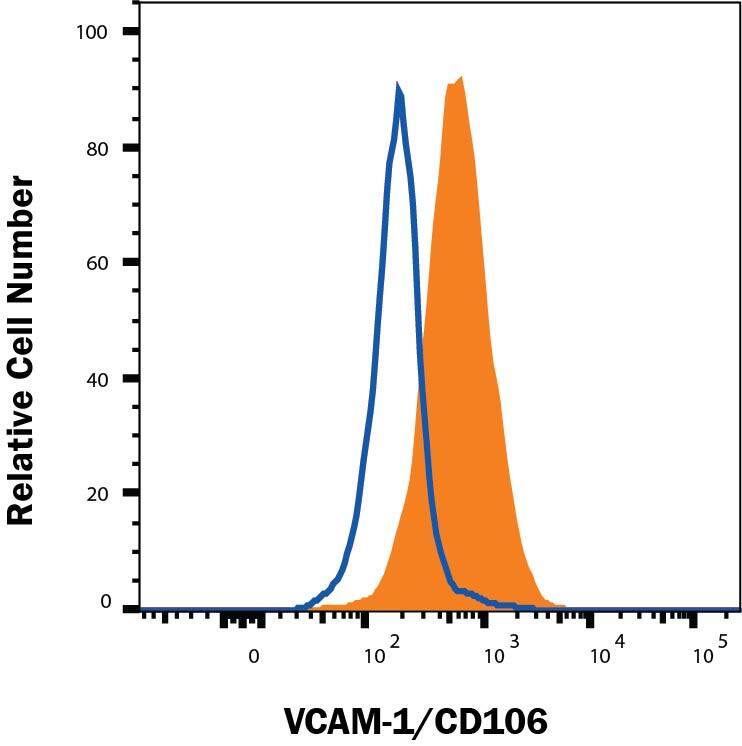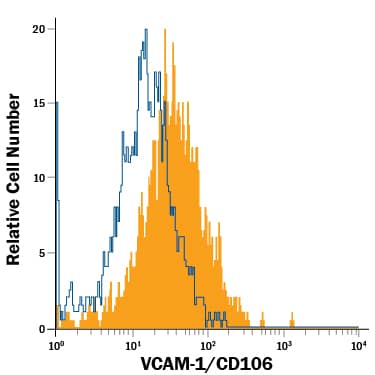Mouse VCAM-1/CD106 Alexa Fluor® 700-conjugated Antibody
R&D Systems, part of Bio-Techne | Catalog # FAB6432N


Key Product Details
Species Reactivity
Applications
Label
Antibody Source
Product Specifications
Immunogen
Phe25-Glu698 (predicted)
Accession # P29533
Specificity
Clonality
Host
Isotype
Scientific Data Images for Mouse VCAM-1/CD106 Alexa Fluor® 700-conjugated Antibody
Detection of VCAM‑1/CD106 in NIH3T3-L1 Mouse Cell Line by Flow Cytometry.
NIH3T3-L1 mouse fibroblast cell line was stained with Rat Anti-Mouse VCAM-1/CD106 Alexa Fluor® 700-conjugated Monoclonal Antibody (Catalog # FAB6432N, filled histogram) or isotype control antibody (IC006N, open histogram). View our protocol for Staining Membrane-associated Proteins.Detection of VCAM‑1/CD106 in bEnd.3 Mouse Cell Line by Flow Cytometry.
bEnd.3 mouse endothelioma cell line was stained with Rat Anti-Mouse VCAM-1/CD106 Alexa Fluor® 700-conjugated Monoclonal Antibody (Catalog # FAB6432N, filled histogram) or isotype control antibody (IC006N, open histogram). View our protocol for Staining Membrane-associated Proteins.Applications for Mouse VCAM-1/CD106 Alexa Fluor® 700-conjugated Antibody
Flow Cytometry
Sample: bEnd.3 mouse endothelioma cell line and NIH3T3-L1 mouse fibroblast cell line
Formulation, Preparation, and Storage
Purification
Formulation
Shipping
Stability & Storage
Background: VCAM-1/CD106
VCAM-1 (CD106), an 85-95 kDa member of the immunoglobulin superfamily, is a type I transmembrane glycoprotein expressed by activated endothelial cells and multiple cell types, including osteoblasts, B cells plus plasma cells, select fibroblasts, Kupffer cells, sensory and autonomic neurons, visceral smooth muscle, simple squamous type I alveolar epithelium, and CD133+ CD24+ renal stem cells. Its expression is typically induced by IL-1 beta, IL-4, TNF-alpha and IFN-gamma. VCAM-1 binds to leukocyte integrins VLA-4, LPAM-1 and CD11c. Over amino acids (aa) 25-698 (the ECD), mouse VCAM-1 shares approximately 75% and 86% aa sequence identity with human and rat VCAM-1, respectively. During the inflammatory adhesion mechanism, activated integrins halt rolling leukocytes and attach them firmly to the vascular endothelium. They do this by binding to their ligands, for example VCAM-1, on endothelium. The VCAM-1: VLA-4 interaction is thought to be involved in the extravasation of white blood cells through the blood vessel wall to sites of inflammation. ELISA techniques have also shown that detectable levels of soluble VCAM-1 are present in the biological fluids of apparently normal individuals. Within the context, a number of studies have reported that levels of VCAM-1 may be elevated or lowered in subjects with a variety of pathological conditions.
Long Name
Alternate Names
Gene Symbol
UniProt
Additional VCAM-1/CD106 Products
Product Specific Notices for Mouse VCAM-1/CD106 Alexa Fluor® 700-conjugated Antibody
This product is provided under an agreement between Life Technologies Corporation and R&D Systems, Inc, and the manufacture, use, sale or import of this product is subject to one or more US patents and corresponding non-US equivalents, owned by Life Technologies Corporation and its affiliates. The purchase of this product conveys to the buyer the non-transferable right to use the purchased amount of the product and components of the product only in research conducted by the buyer (whether the buyer is an academic or for-profit entity). The sale of this product is expressly conditioned on the buyer not using the product or its components (1) in manufacturing; (2) to provide a service, information, or data to an unaffiliated third party for payment; (3) for therapeutic, diagnostic or prophylactic purposes; (4) to resell, sell, or otherwise transfer this product or its components to any third party, or for any other commercial purpose. Life Technologies Corporation will not assert a claim against the buyer of the infringement of the above patents based on the manufacture, use or sale of a commercial product developed in research by the buyer in which this product or its components was employed, provided that neither this product nor any of its components was used in the manufacture of such product. For information on purchasing a license to this product for purposes other than research, contact Life Technologies Corporation, Cell Analysis Business Unit, Business Development, 29851 Willow Creek Road, Eugene, OR 97402, Tel: (541) 465-8300. Fax: (541) 335-0354.
For research use only
